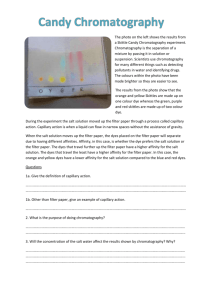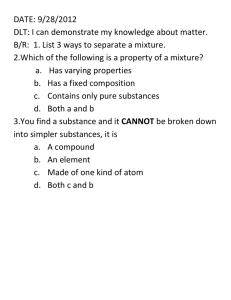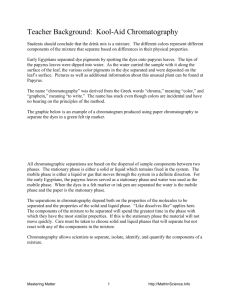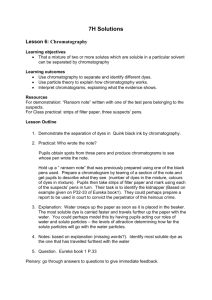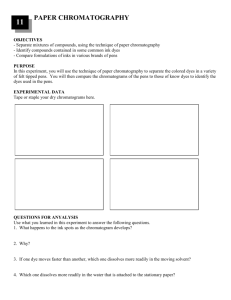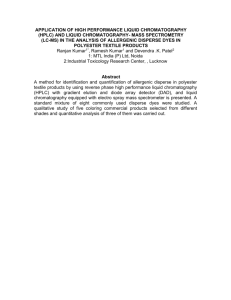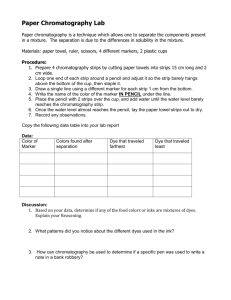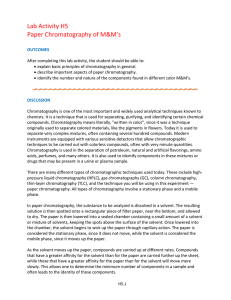Chromatography of Food Dyes Lab Lab Food Dye
advertisement
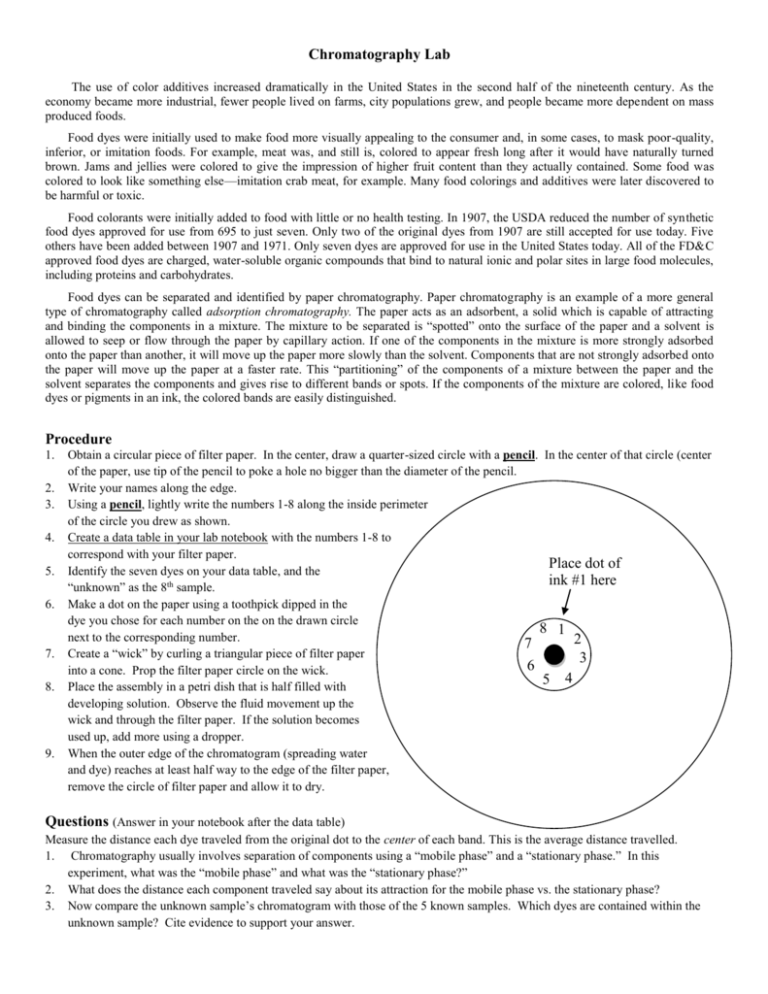
Chromatography Lab The use of color additives increased dramatically in the United States in the second half of the nineteenth century. As the economy became more industrial, fewer people lived on farms, city populations grew, and people became more dependent on mass produced foods. Food dyes were initially used to make food more visually appealing to the consumer and, in some cases, to mask poor-quality, inferior, or imitation foods. For example, meat was, and still is, colored to appear fresh long after it would have naturally turned brown. Jams and jellies were colored to give the impression of higher fruit content than they actually contained. Some food was colored to look like something else—imitation crab meat, for example. Many food colorings and additives were later discovered to be harmful or toxic. Food colorants were initially added to food with little or no health testing. In 1907, the USDA reduced the number of synthetic food dyes approved for use from 695 to just seven. Only two of the original dyes from 1907 are still accepted for use today. Five others have been added between 1907 and 1971. Only seven dyes are approved for use in the United States today. All of the FD&C approved food dyes are charged, water-soluble organic compounds that bind to natural ionic and polar sites in large food molecules, including proteins and carbohydrates. Food dyes can be separated and identified by paper chromatography. Paper chromatography is an example of a more general type of chromatography called adsorption chromatography. The paper acts as an adsorbent, a solid which is capable of attracting and binding the components in a mixture. The mixture to be separated is “spotted” onto the surface of the paper and a solvent is allowed to seep or flow through the paper by capillary action. If one of the components in the mixture is more strongly adsorbed onto the paper than another, it will move up the paper more slowly than the solvent. Components that are not strongly adsorbed onto the paper will move up the paper at a faster rate. This “partitioning” of the components of a mixture between the paper and the solvent separates the components and gives rise to different bands or spots. If the components of the mixture are colored, like food dyes or pigments in an ink, the colored bands are easily distinguished. Procedure 1. 2. 3. 4. 5. 6. 7. 8. 9. Obtain a circular piece of filter paper. In the center, draw a quarter-sized circle with a pencil. In the center of that circle (center of the paper, use tip of the pencil to poke a hole no bigger than the diameter of the pencil. Write your names along the edge. Using a pencil, lightly write the numbers 1-8 along the inside perimeter of the circle you drew as shown. Create a data table in your lab notebook with the numbers 1-8 to correspond with your filter paper. Place dot of Identify the seven dyes on your data table, and the ink #1 here “unknown” as the 8th sample. Make a dot on the paper using a toothpick dipped in the dye you chose for each number on the on the drawn circle 8 1 next to the corresponding number. 2 7 1 Create a “wick” by curling a triangular piece of filter paper 3 6 into a cone. Prop the filter paper circle on the wick. 5 4 Place the assembly in a petri dish that is half filled with developing solution. Observe the fluid movement up the wick and through the filter paper. If the solution becomes used up, add more using a dropper. When the outer edge of the chromatogram (spreading water and dye) reaches at least half way to the edge of the filter paper, remove the circle of filter paper and allow it to dry. Questions (Answer in your notebook after the data table) Measure the distance each dye traveled from the original dot to the center of each band. This is the average distance travelled. 1. Chromatography usually involves separation of components using a “mobile phase” and a “stationary phase.” In this experiment, what was the “mobile phase” and what was the “stationary phase?” 2. What does the distance each component traveled say about its attraction for the mobile phase vs. the stationary phase? 3. Now compare the unknown sample’s chromatogram with those of the 5 known samples. Which dyes are contained within the unknown sample? Cite evidence to support your answer.
